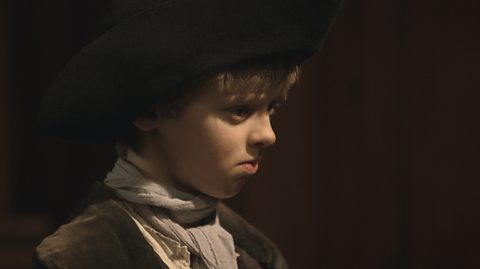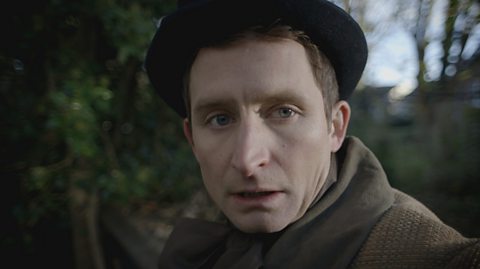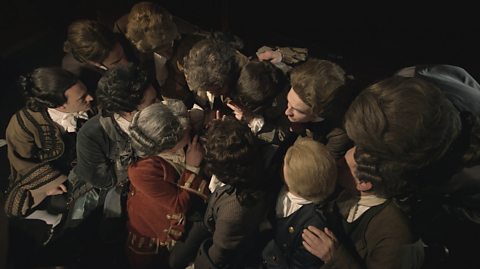COURT REPORTER:I am the court reporter.
COURT REPORTER:Since 1674, every trial that's been played out between these walls at London's Old Bailey court, every single one, has been faithfully recorded by a reporter like me.
COURT REPORTER:I sat just here.
COURT REPORTER:'I wrote down what was said by whom.
COURT REPORTER:'And now you, some while later, can listen in.
COURT REPORTER:'You can press an ear against these walls and hear once again these voices from the past.
COURT REPORTER:'Now here's a case of politics and crime entwined.' Where respectable ladies are prepared to do the unthinkable and defy the law.'
COURT REPORTER:'It's the year 1912.' At this moment in time, women of this country do not have the right to vote.
COURT REPORTER:'Campaigning to change this fact, the Suffragettes.
COURT REPORTER:'At the head of the Suffragettes is one Emmeline Pankhurst.'
COURT REPORTER:On trial here for the charge of inciting others to commit criminal acts.
COURT REPORTER:'On trial, you could say, a bigger picture.'
COURT REPORTER:How far would you go, to change the world?
COURT ANNOUNCER:Pankhurst, Emmeline. Hereby charged with conspiring with others to unlawfully and maliciously damage and incite others to unlawfully and maliciously damage certain property, to wit -
COURT ANNOUNCER:glass windows on 54 counts, the property of the liege subjects of our lord the king.
COURT REPORTER:Right now a critical bill is in the hands of the government. It's what all the protesting has been for
COURT REPORTER:but, just as the prime minister was about to sign on the dotted line, it looks as though the whole enterprise might be derailed and women will be denied the right to vote.
COURT REPORTER:Denied, as they see it, their political freedom.
PROSECUTOR:Gentlemen, let us be clear, the question of women's suffrage is not at issue here.
PROSECUTOR:Rather, we are to concern ourselves with the question of incitement to criminal activity.
PROSECUTOR:I will show, that the defendant gave speeches at public meetings, with the explicit intent, of inciting those attending to partake in what was described as militancy.
PROSECUTOR:I will also show that written materials were published and distributed with the express intent of recruiting supporters to militancy in general and expressly to the protest on the 4th of March, at which, 54 windows were broken.
PROSECUTOR:I should like to call my first witness, Detective Sergeant, Frederik Everest.
FREDERIK EVEREST:I swear by almighty god that the evidence I shall give shall be the truth the whole truth and nothing but the truth.
PROSECUTOR:Detective Sergeant Everest, you attended a meeting on October the 26th, can you tell us what you heard?
FREDERIK EVEREST:I took longhand notes of Mrs. Pankhurst's speech and made a report of the speeches. One extract is as follows - It is becoming clear that the prime minister, Mr Herbert Asquithβ
PANKHURST:-Wants to make a bill so all-encompassing, so unworkable, that many who now support it would drop it, denying at the last hurdle the right to vote we have been fighting for.
FREDERIK EVEREST:I understood Mrs. Pankhurst to say that militancy was not going on at that time but she said "If Mr. Lloyd George, the home secretaryβ"
PANKHURST:Forced his amendment, militancy would be again started.
PANKHURST:We are watching.
PROSECUTOR:So, October the 26th, gentlemen. What was said at that meeting was not a call to action but a wait and see.
PROSECUTOR:I will show, that by February of the following year, the tenor of the defendant's public words had changed. Detective Sergeant Everest, would you please read an extract from the speech the defendant made on February the 15th.
FREDERIK EVEREST:"Great as have been the need on previous occasionsβ"
PANKHURST:The need now is greater still.
PANKHURST:The people of China, won freedom at the price of blood but the women of England can win freedom only at the price of a few panes of glass!
PANKHURST:Since we cannot win freedom by women's ways, then I am going out to throw my stone with the rest of you.
DEFENCE:I ask sir that the whole of the speech be read aloud to better appreciate the context.
FREDERIK EVEREST:"If the home secretary continues in his efforts to wreck the billβ"
PANKHURST:Then we must commit to act by storm.
PANKHURST:But if we undertake this action on a sufficiently large scale, then victory will be ours.
PANKHURST:The militant woman must create a crisis. A difficulty from which all concerned are eager to escape. Then, and then only, will women become politically free.
JUDGE:May I remind you that the allegation is that the accused entered into a conspiracy to incite certain persons to commit breaches of the law but how the changes of policy of this or that minister has any bearing on the issue now being tried is difficult to see.
DEFENCE:It is part of the defence that these occurrences arose because of the breaches of faith of ministers.
DEFENCE:We say, and I believe we are entitled to say, the real criminals are not the persons in the dock.
DEFENCE:The persons who are guilty of incitement are the ministers of the government.
JUDGE:The question we have to answer is only -
JUDGE:whether Mrs. Pankhurst did or did not incite others to break the law.
PROSECUTOR:-I shall now show that this incitement was explicit in materials written and published by Mrs. Pankhurst and her colleagues. I would like to call George Eaton Hart printer of Clement's Press, Portugal Street.
PROSECUTOR:Mr. Hart, please tell the court your engagement with the Suffragettes.
MR HART:My firm has for some time printed the publication, Votes For Women. About 30,000 copies of which, we printed weekly. On March the 4th, I saw the proof of an article titled "Broken Windows" in this publication and I declined to print it.
PROSECUTOR:And your reasons for declining to print this article?
MR HART:We declined to print the following -
MR HART:"Democracy has never been a menace to property. I will tell you what has been a menace to property - when power was withheld, when they had no voice in the government- when they had no means of securing readdress, except by violence.
MR HART:Then property has, many times, been swept away."
PROSECUTOR:In that same paper, gentlemen, a paragraph headed -
PROSECUTOR:"Be prepared for action, a call to arms. On Tuesday next, at 7:30pm The Caxton hall will be crowded with women, who will assemble for the sole purpose of resolving upon such action, whether militant or otherwise as the prime minister's statement may render necessary."
PROSECUTOR:Is that not, explicitly, an invitation and an incitement to participate in militant action? Its intent is perfectly clear.
COURT REPORTER:So this is what happened next.
COURT REPORTER:The prime minister made his choice, did as was feared and quashed the bill.
COURT REPORTER:All the years of marching and protesting, it seems, have come to nothing.
COURT REPORTER:For the Suffragettes, a line is drawn.
COURT REPORTER:A stark choice - do nothing or do something more extreme?
COURT REPORTER:I do not think these ladies are of a mind for backing down.
PROSECUTOR:So, thus equipped, on March the 4th, the women's social and political union gathered members of the pavilion to decide upon militant action. I shall call police constable, Thomas Whitbread, who attended this meeting.
PROSECUTOR:Constable Whitbread, can you tell us what you saw at the meeting?
WHITBREAD:There was some 900 who attended the meeting.
PANKHURST:-Politically free.
WHITBREAD:'In the early evening, the women left in small groups.
WHITBREAD:'Several officers were instructed to follow. I followed two who went to Whitehall and there broke two windows at the war office.'
JUDGE:Mrs. Pankhurst, do you have anything you wish to say to this court?
PANKHURST:I submit that there is a higher law.
PANKHURST:We stand here in this dock, defending ourselves against a charge which may mean long terms of imprisonment.
PANKHURST:Let them give us seven years penal servitude if they like but they shan't give it us for nothing.
PANKHURST:We shall do our bit.
PANKHURST:Even if it is burning down a palace.
PANKHURST:Then we shall go into prison and leave the others to join us, one by one.
JUDGE:Are you, Mrs. Pankhurst, calling any witnesses?
PANKHURST:I am not able to call the only witnesses I should desire to call.
PANKHURST:They are the prime minister and the home secretary.
PANKHURST:To the ministers, who I say incited us to throw our stones, to them I say this -
PANKHURST:beware how you incite us to do worse.
DEFENCE:I should like to call Ms. Ethel Smythe.
ETHEL:-I am a doctor of music. I was present at the meeting and I heard your speech. I was not incited by what I heard to play the part I played.
ETHEL:Before I heard your speech, I had already made up my mind to make some form of protest.
ETHEL:I wrote and said I am coming.
DEFENCE:-Ms. Liliane Ball
LILIANE:I am a dress-maker from Tooting. Of my own accord, I took up a hammer, on which was written "Better broken windows, than broken promises." I put the hammer up my sleeve. I broke a window of the United Service Museum.
DEFENCE:Ms. Henrietta Wilson.
HENRIETTA:I did not see, how any self respecting woman could stay at home. I broke two windows at the Gardenia restaurant.
DEFENCE:No further questions.
JUDGE:Gentlemen. It now falls to you to make your decision.
JUDGE:May I remind you that at issue here is the question of whether the defendant is guilty of the charge of incitement to criminal acts.
COURT REPORTER:So now they make up their minds. Twelve men to pass judgement on a woman who seeks to change the balance of power.
COURT REPORTER:To shake the dust off them, you might say. To put a cat amongst the pigeons.
COURT REPORTER:Whatever they decide, there's no denying that these Suffragettes are not about to give up their fight.
JUDGE:Have you reached your verdict?
JUROR:On the charge of conspiring together with others to unlawfully and maliciously damage and incite others to unlawfully and maliciously damage certain property, we find the defendant E. Pankhurst, guilty.
JUDGE:Emmeline Pankhurst, I hereby sentence you to nine months imprisonment.
COURT REPORTER:Well, another day. Another historic trial. A window on the wider world. A moment captured in the tides of time, and all most faithfully recorded.
COURT REPORTER:I must tell you, there will be six more years of fighting before finally women win political freedom and the right to vote.
In 1912, suffragette Emmeline Pankhurst, is on trial at the Old Bailey for inciting others to commit criminal acts.
The question at the heart of the trial is whether or not Mrs Pankhurstβs words incited violent acts. As the trial unfolds, witness testimony reveals the historic struggle for women's right to vote.
The case is played out in the court room with dramatic flashbacks to illustrate the crime. The court reporter sets the scene and offers insight and context.
This film is from the series Tales from the Old Bailey.
Teacher Notes
This powerful case can be used to highlight the way it can be difficult to divorce the theoretical impartiality of the criminal justice from the contemporary politics of a period.
Pupils could consider whether the prosecution actually had enough evidence to convict Emmeline Pankhurst on the charges made.
They could role-play different members of the jury deliberating on their verdict, with some cast as jurymen utterly opposed to women's suffrage debating with jurymen with more liberal views. This discussion could be used to illustrate the point that jurors may be influenced by their political views in cases like this over and beyond the evidence actually presented in court.
Wider questions could be discussed, such as to who won or lost this case politically. For example, were the suffragettes actually hoping for a conviction and, if so, why? Pupils could consider who might have been more embarrassed by an acquittal: the government or the suffragettes?
The politics of the case could also be contrasted with the way government ministers and suffragettes co-operated during World War One, which actually resulted in parliament allowing some women the vote at the end of the war.
Other discussions could be held about the extent to which it is valid to ever break the law or use violence to further a particular cause. For example, in the modern day cases such as animal rights activists that release laboratory animals from captivity, or death threats to staff at clinics providing abortion services.
This clip could be contrasted with the case of Catherine Hays to discuss the extent (if at all) changes in the conduct of trials have made it more or less difficult for a woman to be tried fairly in court.
This clip could also be used by pupils studying the Liberal reforms 1906-1914.
Curriculum Notes
These clips are relevant for teaching history at Key Stage 2 and Second level, particularly when studying the Edwardians, the suffragettes or the 1906-1914 Liberal reforms.
More from Tales from the Old Bailey
The Blackguard Boys. video
A historic trial dramatised from the Old Bailey archives exploring the case of the Blackguard Boys from 1731.

The Grave Robber. video
After a grave in the churchyard is found empty, the vicar and his surgeon son are both put on trial for body-snatching.

The Murderess. video
A severed head is found floating in the Thames. The victim's wife is tried for his murder, but during the trial, his abuse of her is revealed.

The Thief Taker General. video
The Thief Taker General, Jonathan Wild, is on trial for organising robberies and then benefiting from returning the stolen goods to the victims.
